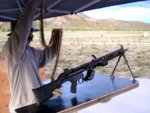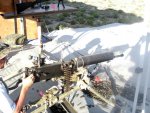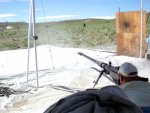While I do believe we are beginning to turn the corner on outrageous demand, there could be some valid reasons for employing our handloading skills to produce ammunition that answers new questions. Those questions involve 'throwaway ammo' that is not intended to have the cases recovered and reloaded, but still needs to benefit from good accuracy loading standards. I'll not get directly into applications for such ammo, but skip to the chase, and deal with how to make it.
All that steelcase TulAmmo and such represents a cheaper supply of one-shot casings. Interestingly, it's actually Boxer primed, but I have yet to try decapping and repriming any. I will, and if it decaps OK, I have the Dillon Super Swage at hand in case there's difficulty with anything related to crimps, etc. My next purchase will be an Ultrasonic cleaner, so cleaning the cases soon after firing could have benefits related to forestalling case corrosion after firing.
But recycling the steel is not part of this discussion at present.
The primed steel cases go bang with enough consistency to be at least considered for what I call 'Mexican Match' ammo production.
I am presently in possession of some batches of ammo I made up by collet pulling the TulAmmo 55FMJ bullets and factory powder, then reassembling using my SRA 69SMK and HDY 75HPBT Match reloads employing Varget propellant.
This is where the project currently sits. Next steps include comparison tests against identical loads made with brass cases and match primers to see how much the accuracy slumps with the 'inferior' primed cases in my own particular.223/5.56 rifles.
At very least my brass and primer supply is not being consumed in the process. And who knows, an application may arise where policing brass is not an option.
Meanwhile, those 55FMJ bullets and factory propellants are not immune from utility for further load development. While not premium components, load development could increase their utility value. They could work rather admirably in my tired and near-to-retirement slow-twist Rem 700VLS .223.
Greg
All that steelcase TulAmmo and such represents a cheaper supply of one-shot casings. Interestingly, it's actually Boxer primed, but I have yet to try decapping and repriming any. I will, and if it decaps OK, I have the Dillon Super Swage at hand in case there's difficulty with anything related to crimps, etc. My next purchase will be an Ultrasonic cleaner, so cleaning the cases soon after firing could have benefits related to forestalling case corrosion after firing.
But recycling the steel is not part of this discussion at present.
The primed steel cases go bang with enough consistency to be at least considered for what I call 'Mexican Match' ammo production.
I am presently in possession of some batches of ammo I made up by collet pulling the TulAmmo 55FMJ bullets and factory powder, then reassembling using my SRA 69SMK and HDY 75HPBT Match reloads employing Varget propellant.
This is where the project currently sits. Next steps include comparison tests against identical loads made with brass cases and match primers to see how much the accuracy slumps with the 'inferior' primed cases in my own particular.223/5.56 rifles.
At very least my brass and primer supply is not being consumed in the process. And who knows, an application may arise where policing brass is not an option.
Meanwhile, those 55FMJ bullets and factory propellants are not immune from utility for further load development. While not premium components, load development could increase their utility value. They could work rather admirably in my tired and near-to-retirement slow-twist Rem 700VLS .223.
Greg
Last edited:




